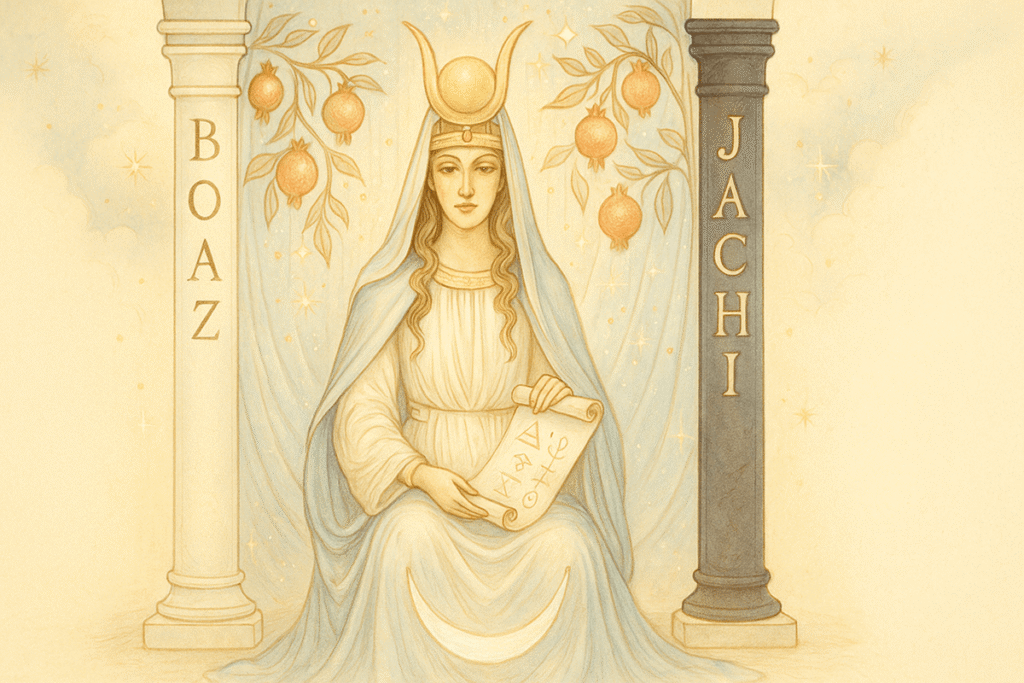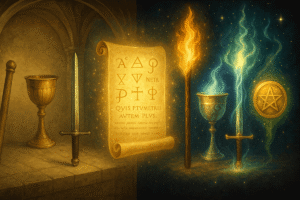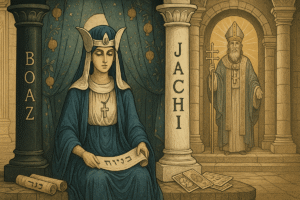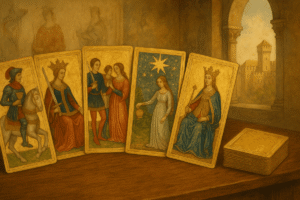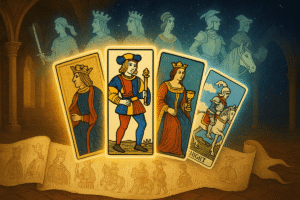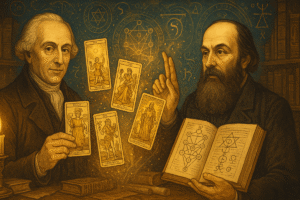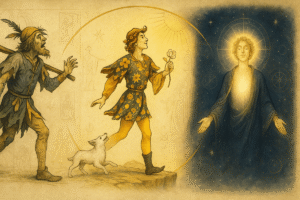Table of Contents
When I first encountered The High Priestess card years ago, I remember feeling an immediate sense of recognition, though I couldn’t quite articulate why. There was something about her serene expression and the mysterious symbols surrounding her that seemed to speak directly to some deeper part of my consciousness. Perhaps you’ve felt something similar when encountering this enigmatic figure.
The High Priestess represents one of the most profound and complex archetypes in the tarot deck. She embodies the realm of intuition, hidden knowledge, and the sacred feminine mysteries that have captivated humanity for millennia. Unlike other cards that might offer more straightforward guidance, The High Priestess invites us into a space of contemplation and inner knowing.
The Sacred Guardian Between Worlds
The High Priestess sits as a guardian between the conscious and unconscious realms, serving as a bridge to deeper understanding. Her positioning in the tarot sequence, following The Magician’s active energy, suggests a necessary pause for reflection and inner consultation before moving forward.
What strikes me most about this archetype is how she doesn’t simply provide answers but rather creates the sacred space where answers can emerge naturally. She represents that quiet voice within us that knows things we haven’t yet learned to articulate. When we encounter The High Priestess energy in our lives, we’re being invited to trust in ways of knowing that extend beyond logic and external validation.
The archetype speaks to the importance of receptivity in a world that often prizes action above all else. She reminds us that sometimes the most profound insights come not from seeking actively but from creating stillness and allowing wisdom to surface organically.
Symbols of Ancient Wisdom
The rich symbolism surrounding The High Priestess connects her to ancient traditions of sacred knowledge and mystery schools. Each element in traditional depictions carries layers of meaning that have evolved across centuries of mystical practice.
Her throne or seat often appears between two pillars, creating what mystics call the “middle pillar” or path of balance. This positioning suggests her role as mediator between opposing forces and her access to the unified field where contradictions dissolve into higher truth.
The pomegranates that frequently appear in her imagery connect her to ancient goddesses like Persephone and Demeter, linking her to cycles of death and rebirth, hidden knowledge, and the fertile darkness from which new life springs. I find it fascinating how these symbols appear across diverse cultures, suggesting something universal about the wisdom The High Priestess represents.
Perhaps most intriguingly, the veil behind her often depicted with flowing patterns suggests both concealment and revelation. The wisdom she guards isn’t hidden to keep it from us but rather because certain truths can only be received when we’ve developed the capacity to understand them properly.
The Pillars of Duality
The twin pillars that frame The High Priestess, traditionally named Boaz and Jachin, derive from ancient Hebrew temple architecture and carry profound symbolic significance. These pillars represent the fundamental dualities that structure human experience: light and shadow, conscious and unconscious, masculine and feminine, known and unknown.
Boaz, typically depicted in darker tones, represents strength and the principle of form. Jachin, often lighter, embodies establishment and the principle of force. Together, they create the gateway through which deeper understanding must pass. The High Priestess sits between them not to choose one over the other but to demonstrate the wisdom that emerges from embracing paradox.
What I find particularly meaningful about this symbolism is how it suggests that wisdom isn’t found by resolving contradictions but by learning to hold them simultaneously. The High Priestess archetype teaches us to become comfortable with uncertainty and to find stability not in fixed answers but in our capacity to remain present with questions.
The pillars also represent the threshold between ordinary consciousness and expanded awareness. When we work with The High Priestess energy, we’re learning to navigate this liminal space where new insights become available.
The Pomegranate Veil and Hidden Mysteries
Behind The High Priestess hangs a veil adorned with pomegranates, one of the most symbolically rich elements in her traditional imagery. This isn’t merely decorative but speaks to layers of hidden knowledge waiting to be discovered through patient inner work.
Pomegranates have been associated with feminine wisdom and the mysteries of death and rebirth across numerous cultures. In Greek mythology, Persephone’s consumption of pomegranate seeds bound her to the underworld, but this binding also granted her unique wisdom and the power to bridge worlds. The High Priestess embodies this same quality of having access to hidden realms while remaining grounded in earthly reality.
The veil itself represents the thin boundary between the seen and unseen, the known and the mysterious. Unlike a solid wall, a veil can be parted, suggesting that the mysteries The High Priestess guards are accessible to those who approach with proper preparation and respect.
I sometimes think about how modern life often encourages us to tear through veils impatiently, demanding immediate access to all knowledge. The High Priestess archetype offers a different approach, suggesting that some wisdom can only be received gradually, through cultivation of patience and inner receptivity.
The Crescent Moon and Intuitive Cycles
At The High Priestess’s feet, the crescent moon connects her to lunar consciousness and the rhythmic nature of intuitive knowing. This symbol links her to ancient moon goddess traditions while also pointing to the cyclical nature of insight and understanding.
The moon’s phases mirror the natural rhythms of intuition, which doesn’t flow constantly but rather moves through periods of clarity and mystery, fullness and emptiness. The High Priestess archetype teaches us to work with these natural rhythms rather than trying to force consistent access to psychic or intuitive information.
The crescent moon specifically represents new beginnings and the emergence of fresh perspectives from the darkness of not knowing. When we connect with The High Priestess energy, we’re often in a phase of transition where old ways of understanding no longer suffice but new clarity hasn’t yet fully emerged.
This lunar connection also emphasizes the receptive quality of The High Priestess’s wisdom. Just as the moon receives and reflects the sun’s light, transforming it in the process, The High Priestess receives information from subtle sources and reflects it back in forms we can begin to understand.
Connecting with Inner Knowing
The High Priestess archetype invites us to develop and trust our own capacity for inner knowing. This isn’t about becoming psychic in some dramatic way but rather about learning to recognize and value the subtle forms of intelligence that operate below the threshold of ordinary consciousness.
When I reflect on times in my own life when The High Priestess energy has been most present, they’re often moments of quiet certainty that arrived without logical explanation. Perhaps you’ve experienced something similar, those moments when you simply knew something without being able to explain how you knew it.
Developing this capacity requires what I might call “comfortable not knowing.” The High Priestess teaches us to rest in uncertainty without anxiety, to trust that understanding will emerge in its own time and way. This is perhaps one of the most challenging aspects of her teaching in our information age.
The archetype also suggests the importance of creating regular spaces for silence and reflection. The High Priestess can’t emerge in environments of constant noise and stimulation. She requires the kind of inner quietude that allows subtle impressions to surface and be recognized.
The Sacred Feminine and Receptive Wisdom
The High Priestess embodies aspects of the sacred feminine that transcend gender, representing qualities of receptivity, intuition, and cyclical wisdom that both men and women can cultivate. Her archetype points to ways of knowing that have been undervalued in cultures that prioritize linear thinking and immediate action.
This receptive wisdom doesn’t mean passivity but rather a different kind of active engagement with life. The High Priestess shows us how to be powerfully present without needing to control outcomes, how to influence situations through being rather than doing.
Her connection to sacred feminine traditions also links her to the honoring of mystery itself. In a world that often demands explanations for everything, The High Priestess suggests that some experiences are meant to remain mysterious, that trying to explain everything can sometimes diminish its power to transform us.
The archetype encourages us to develop comfort with the unknown and to recognize that our rational minds, while valuable, represent only one way of engaging with reality.
Modern Applications of Ancient Wisdom
In contemporary life, The High Priestess archetype offers particularly relevant guidance for navigating information overload and decision fatigue. Her energy teaches us to distinguish between data and wisdom, between knowing facts and understanding truth.
Perhaps you’ve noticed how having access to endless information doesn’t necessarily make decisions easier. The High Priestess suggests that sometimes the wisest course involves stepping back from external input and consulting our deeper knowing about what truly serves our highest good.
The archetype also speaks to the importance of honoring non rational ways of processing experience. In therapeutic contexts, in creative work, and in spiritual development, The High Priestess energy helps us access insights that emerge from synthesis rather than analysis.
Her influence can be felt in the growing recognition of the value of mindfulness, meditation, and other contemplative practices that create space for deeper forms of knowing to emerge naturally.
Questions for Self Reflection
Rather than offering definitive interpretations, The High Priestess archetype invites us into relationship with mystery through meaningful questions. What parts of your life feel ready for deeper exploration? Where might you be trying to force understanding instead of allowing it to unfold organically?
Consider the areas where you’ve been seeking external validation for decisions that ultimately only you can make. The High Priestess energy suggests that you already possess the wisdom you’re seeking, though it may require patience and inner attunement to access it fully.
How comfortable are you with not knowing? This archetype challenges us to find strength in uncertainty and to recognize that some of life’s most important questions don’t have simple answers but rather invite ongoing exploration and relationship.
The High Priestess reminds us that wisdom isn’t something we acquire once and possess permanently but rather a living relationship we cultivate over time. Through patient attention to our inner landscape and respectful engagement with mystery, we gradually develop the capacity to navigate life’s complexities with greater grace and insight.
In working with this powerful archetype, we discover that the answers we seek often emerge not through searching frantically outside ourselves but through creating the inner conditions where deeper knowing can naturally arise.
Frequently Asked Questions
What do the letters B and J on the pillars mean?
The B stands for Boaz (meaning “in his strength”) and J represents Jachin (meaning “he establishes”), which were the names of two bronze pillars that stood at the entrance to Solomon’s Temple in ancient Hebrew tradition. Together, these pillars represent fundamental dualities like light and shadow, strength and establishment, creating the sacred threshold through which deeper wisdom becomes accessible.
Why are pomegranates featured so prominently on the veil?
Pomegranates are sacred to Persephone, who ate pomegranate seeds in the underworld and was forced to return every year, making them symbols of the cycle between life and death, abundance, and the divine feminine. The pomegranate imagery connects The High Priestess to ancient mystery traditions and suggests that the wisdom she guards involves understanding transformation and the natural cycles of existence.
What does the crescent moon at her feet represent?
The crescent moon symbolizes her connection with the divine feminine, intuition, the subconscious mind, and the natural cycles of the moon. This lunar imagery emphasizes that intuitive wisdom operates in rhythms and cycles rather than as a constant force, reminding us to work with these natural ebbs and flows rather than expecting steady access to insight.
How is The High Priestess different from The Hierophant?
While The Hierophant represents structure, tradition, external authority, and wisdom passed down through institutions, The High Priestess embodies inner knowing and personal spiritual truth. The High Priestess invites you to look within for answers rather than seeking validation from external sources or established systems, making her the complement to The Hierophant’s more formal, structured approach to knowledge.

